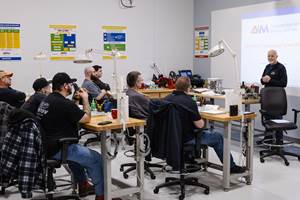Evaluating Training Resources
Finding, Training & Retaining Employees, Part 12
In August, we looked at people and processes as they relate to training needs analysis and the importance of implementation prior to training program development. Here we will review training resources and ways to identify gaps in your program.
Training Resources
The ultimate goal of a training needs analysis is to build the foundation of a training program driven by processes and standardization, so a thorough evaluation of training resources is necessary. Training resources are any tools used to communicate knowledge and/or skills to a person or group of people. They come in many forms, from a simple checklist on a sticky note to a full set of manuals, books and tests.
Start your training program evaluation by listing everything you know that you are using. For example, online classes, check sheets, books, machine manuals, community college classes, notes from vendor or supplier training, safety training materials, etc. Next, make a list of the resources you think you might be using, and then validate whether or not you are actually using them. Once you have these lists, begin to categorize and organize. For example, sort by training for safety, machining, design, EDM, etc. Once all the resources are sorted appropriately, you will discover what is missing and what is unnecessary. In other words, you will be able to clearly see what should be there.
When evaluating your existing training resources, it may help to think of the materials in terms of attitude, knowledge or skills. Then ask yourself, “Are we providing the proper balance in each area of training to develop the attitude, knowledge and skills of the trainee?” Even the most basic learning events must ensure that the proper attitude is set with the correct knowledge base to support the development of value-added skills.
Next, add or subtract materials from your list to ensure the training will be complete. Now you can work on standardizing the delivery of the final list so everything used for training will be accessible to each potential learner. Using an open-source (free) learning management system is recommended, and this can be installed on your network for a nominal fee by a computer programmer. This provides a common learning platform where every employee has a secure login to access the necessary training, which may include videos, documents, links and tests.
In the next part of this series, we will examine constraints that may exist in the company that prevent successful training needs analysis.
Related Content
Unique Mold Design Apprenticeship Using Untapped Resources
To help fill his mold design skills gap, Jeff Mertz of Anova Innovations, is focused on high schools and underprivileged school districts, a school that has lower graduation and college entrance rates. The goal is a student-run enterprise.
Read MoreMold Maintenance Continues to Matter: Enhanced Training Program in a New Facility
I attended a MoldTrax mold maintenance workshop in 2019 and shared my experiences, and despite changes in ownership, the workshop's remarkable value endures, as discussed in a recent Q&A with the current leadership.
Read MoreThe Role of Social Media in Manufacturing
Charles Daniels CFO of Wepco Plastics shares insights on the role of social media in manufacturing, how to improve the “business” side of a small mold shop and continually developing culture.
Read MoreTackling a Mold Designer Shortage
Survey findings reveal a shortage of skilled mold designers and engineers in the moldmaking community, calling for intervention through educational programs and exploration of training alternatives while seeking input from those who have addressed the issue successfully.
Read MoreRead Next
Finding, Training & Retaining Employees
In this multi-part series of articles, contributor Ryan Pohl, a journeyman CNC machinist who also holds a master's degree in industrial training and development, addresses the skilled-labor shortage and its potential to dramatically hinder the future sustainability and growth of the moldmaking industry.
Read MoreMore Related Technical Instruction Justification
Finding, Training & Retaining Employees, Part 8
Read MoreHow to Use Strategic Planning Tools, Data to Manage the Human Side of Business
Q&A with Marion Wells, MMT EAB member and founder of Human Asset Management.
Read More
























